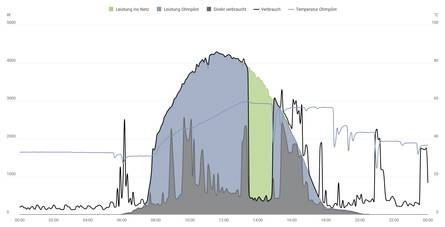

Generating Hot Water with Solar Energy
Fronius Ohmpilot, Heating Rods and More
Solar systems are used for power generation. However, solar energy can also be used to heat domestic and drinking water. This can be done either directly through solar thermal energy or indirectly with solar power. We outline the most important options – and all their advantages.
Table of content
Generating Hot Water with Photovoltaics – The Possibilities
Photovoltaics do not heat water. But the solar power can be used to operate the corresponding electrical systems. These include:
- Heat pumps
- Instantaneous water heaters
- Heating rods
These are ultimately just energy consumers like any other. When hot water is needed, the instantaneous water heater is switched on for example. If the solar energy from the roof is sufficient, it is operated with one's own solar energy.
It becomes particularly worthwhile with a buffer storage tank in which hot water can be stored. Of course, even with such a storage tank, there is a certain basic demand that must be met, regardless of whether the sun is shining or not. However, intelligent control can utilize a principle that is also known from batteries and electric cars: surplus charging. If excess solar energy were fed into the grid, warm water could instead be generated and stored in the buffer storage tank. This indirectly turns the buffer storage tank into a storage for solar energy.
Intelligent Heat with the Fronius Ohmpilot
A good way to efficiently generate hot water or heating water is the Fronius Ohmpilot. Excess solar energy that would be fed into the public grid goes directly to heat-producing consumers via the Fronius Ohmpilot:
- the heating rod in the storage tank
- towel dryer in the bathroom
- infrared heating
- ...
Even smaller surpluses from the PV system are consumed continuously and not fed into the grid.
The PV energy is thus used as efficiently as possible in one's own household and the self-consumption share is maximized. This not only positively affects the return on the PV system but also the energy costs. In the summer months, almost all hot water consumption can be covered with solar energy. The primary heating source usually remains completely switched off, which also increases the service life of the heating system.

How the Heat Solution with the Fronius Ohmpilot Works
The Fronius Ohmpilot is a consumption regulator that uses the excess energy from the photovoltaic system for hot water preparation in the boiler. The hot water is therefore not heated by the conventional heating system, for example, a gas, oil, or pellet heating system, but is generated with solar energy. A major advantage of this solution is the stepless regulation from 0 to 9 kW. This allows the PV power to be used very efficiently, even with minimal surpluses.
The Advantages at a Glance
- Hot water supply with photovoltaics for over 8 months a year mostly possible
- Increase self-consumption quota to up to 100%
- Reduce energy costs
- Extend the service life of the primary heat source
- Stepless control from 0 to 9 kW for optimal use of surpluses from the solar system
- Visualization of energy use for hot water possible
- Use also possible in combination with zero feed-in
The Alternative: Smart Home Hot Water Controller
The Smart Home Hot Water Controller from SolarEdge uses a similar principle with similar advantages. The device is available with power stages from 3 kW to 5 kW.
Heating Rods for Heat Generation with Solar Energy
In the Krannich Solar webshop, you will find various heating rods that are suitable for use with the Fronius Ohmpilot or the Hot Water Controller from SolarEdge:
- Askoma Heating Rod for Fronius or SolarEdge with power stages from 3 to 9 kW.
- Askoma Screw-in Radiator, suitable for Huawei and Kostal in addition to the two manufacturers mentioned. Power stages from 3.5 to 5.2 kW.
- My-PV Elwa-E2 heating rod with a maximum heating output of 3.5 kW. It is compatible with a wide range of inverters.
Important Questions about Hot Water Generation with Photovoltaics
How much solar power is needed for hot water?
To heat one liter of water by one degree celcius, 1.16 Wh must be supplied. To heat the water in a full 500l buffer storage tank from 10 to 60 degrees, 500*50*1.16 Wh=29,000 Wh or 29 kWh must therefore be applied.
A heating rod with 9 kW would need 29 kWh/9 kW=3.2h hours – and would have to be supplied with the full 9 kW PV power during this time. In theory, a 9 kWp system would be sufficient for this under perfect sunlight, but energy is lost on the way from the modules to the buffer storage tank. How much this is depends on the efficiency of the individual components.
The size a PV system should be depends on the total energy consumption of a household. With a hot water consumption of 30 liters per person and day, about 635 kWh per year and person is added to the electricity consumption just for hot water. If the electricity consumption in a 4-person household averages 4,500 kWh, about 2,500 kWh would be added for hot water. This totals 7,000 kWh and could be covered by a 7 kWp system. Those who strive for more autonomy can also double the system and add a storage system.
When is a PV heating rod worthwhile? Is a heating rod in the buffer storage tank sensible?
A PV heating rod is worthwhile if the solar system produces a lot of energy that would otherwise not be consumed in the household, i.e. is fed into the grid. Anyone who wants to calculate the amortization must offset the additional costs for the PV heating rod with two values:
- with the saved electricity costs that would arise if the water was heated without PV
- with the income that would be gained from selling the PV electricity.
How long does a heating rod with 3 kW power take to heat water?
To heat one liter of water by one degree, 1.16 Wh must be expended. According to the Consumer Advice Center, water should be heated to at least 60 degrees to meet hygiene requirements. To heat a storage tank with a capacity of 300 liters from, for example, 10 to 60 degrees, 17.4 kWh of energy must be used. A heating rod with 3 kW power would need almost 6 hours for this.
If 150 liters of water are used for showering at a water temperature of about 40 degrees, then about 60 liters of hot water must be used. This corresponds to an energy input of about 3.5 kWh. The 3 kW heating rod would need about one hour and ten minutes for this. Heat and conversion losses not included.
Which is better, solar thermal or solar power?
Solar thermal refers to the direct heating of water in the household by solar energy. Photovoltaics is the generation of electricity by solar energy. So these are two completely different technologies, even if the modules or collectors on the roof look similar. Which of the two is better depends on the benchmark.
On the one hand, solar thermal can heat the water directly without the detour via inverters and power cables. In addition, a solar thermal system can be easily dimensioned to match water consumption – and there is still room for PV on the roof.
On the other hand, it is often advisable with a PV system to fully utilize the available space. Excess power produced can be sold or stored. So if you are planning to invest in a PV system anyway, it is often better to use this one technology as efficiently as possible and not to install two different systems on the roof.
If the primary goal is to save CO2, you should consider solar thermal, at least according to the Austrian Association IG Lebenszyklus Bau. However, the maintenance effort for solar thermal is higher. If, on the other hand, profitability is important, you have to calculate carefully, because it depends on it. However, researchers from the Fraunhofer Institute have shown in a study that PV is at least in some cases more profitable than solar thermal.